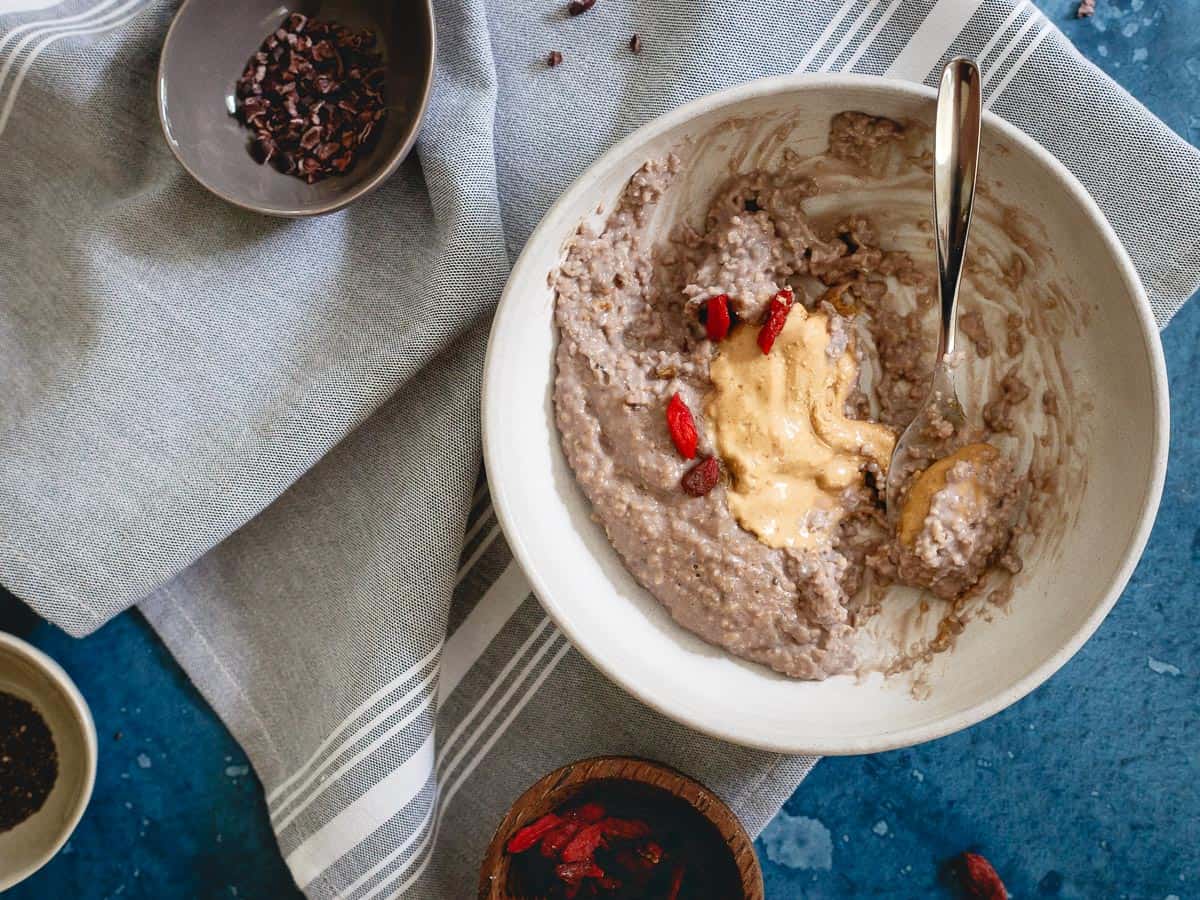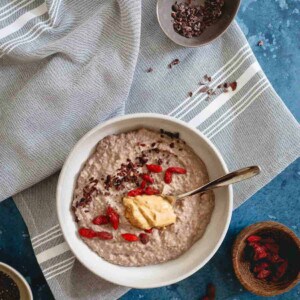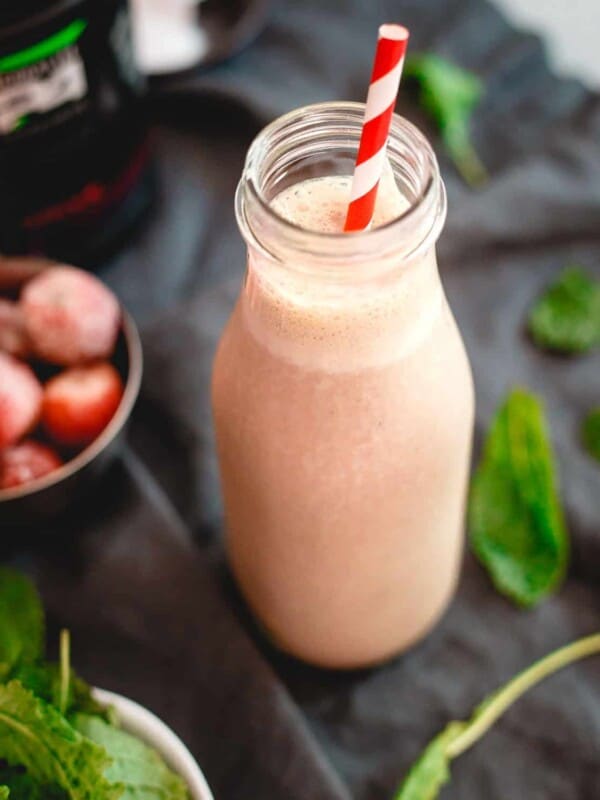This is a sponsored conversation written by me on behalf of Herbalife Nutrition. The opinions and text are all mine.
In the overall sense of nutrition and dieting, I think (or I hope) we all know the basic underlying principle that “calories in vs. calories out” is what ultimately plays the most important role.
For the general population, it’s enough but for those of us that consider ourselves athletes in any way, shape or form or, are just looking to get the most bang for our workout buck, there’s a little bit more science that goes into what you should eat and how you should time it around your workouts.

I connected with Herbalife Nutrition sports nutrition expert Dana Ryan, Ph.D., to talk about eating around training.
Up for discussion is what to eat before, during and after your workouts so that you feel properly fueled and can be sure your muscles are getting what they need to grow and recover.
Before we get started though, let’s go over some basics we all learned at one point in time in middle school biology class but have likely since been forgotten, especially with all the dieting misconceptions floating around these days and the rising popularity of niche diets like keto, paleo and the like.
There are 3 macronutrients that make up a diet: protein, carbohydrates and fat.
Protein – The one macronutrient everyone automatically thinks of when it comes to muscle growth and yes, the proper amount of protein is needed for stimulating muscle development. Athletes should be conscious of getting the right amount of protein throughout the day and spreading it as evenly as possible throughout meals so that muscle development is stimulated consistently. That said, protein is not the be all and end all to muscle development as one might think.
Carbohydrates – This delicious macronutrient, which we all love, fuels activity, including your muscles when they’re working out hard during training. Without carbs, the body will turn to protein for fuel which in turn takes it away from its otherwise primary goal of building muscles. See how a lack of carbs in your diet can be cause for concern now? Keto sounds a bit dumb now without medical necessity, huh?
Fat – Another macronutrient that’s gotten a bad rep in the past (although that’s changing as of late it seems, yay!) Small amounts of the right kinds of fat are very important because they contain fatty acids that the body needs for cell growth (including muscle cells) and can’t produce on its own.
Fair warning – There’s going to be a lot of talk of carbohydrates in this post so for any of you out there with the mindset of “carbs are bad” or “carbs make you fat” my goal is to prove you wrong today with real biologically/scientifically sound information, not just something you heard someone say on social media and took for fact.

Eating Around Training
What to Eat Before Your Workout
Focus on – high carbohydrates, moderate protein, low fat
A small meal high in carbohydrates will help fuel your upcoming activity. Think of it as gas in your car’s tank. You need it to get from point A to point B. Within an hour of starting your workout, look for foods that are more quickly absorbed, things in liquid form are great for this like a protein shake. Since you have a little bit of time, moderate protein intake is good in helping to slow digestion just enough to let the carbohydrates enter the bloodstream and do their thing. Fats should be avoided right before a workout because they tend to slow digestion. Same goes for high fiber foods as well. So, save that spoonful of peanut butter or bowl of rice for after the workout, not before.
I’ve worked with a nutrition coach for the last 2 years and the macronutrient breakdown I try to hit before my workouts is about 15g protein/30g carbs for my body/physique (for context – I’m 5’7″ and feel/look/perform my best around 132-134 pounds).
Here are some of my pre-workout go to “meals”:
-0% Greek yogurt, berries, cinnamon, spoonful of granola
-plain rice cake with 1/2 smashed banana (or sometimes jelly instead) and cinnamon, some 0% Greek yogurt on the side
-scoop of vanilla whey protein powder, oat bran, unsweetened almond milk – cooked in microwave, dollop of Greek yogurt on top to make it creamy. See the recipe for chocolate protein oat bran below for this one’s post-workout cousin.
–High protein cinnamon cake bars
I look forward to this “meal” all day. Since I work out around 5pm most of the time, I consider it my late afternoon snack/dessert and I try to have fun with it.
What to Eat During Your Workout
Focus on – high carbohydrates
This one deserves a little bit of explanation. Intra-workout nutrition really only needs to be considered if your workouts are lasting an hour or more and are of relatively high intensity. Otherwise, it’d be akin to downing some of those (in my opinion, disgusting) gel type things marathon runners use when running just a 5k. It’s overkill and unnecessary.
If you’re in the small percentage of people this does apply to, however, you want to focus on carbohydrates and hydration here. We’ll talk more about hydration and Herbalife Nutrition’s CR7 Drive product (a great go-to for intra-workout nutrition) in an upcoming post but, for the carbohydrate piece, we’re talking liquids here not solid foods.
Sports drinks usually do well in this kind of situation (see how to make a homemade sports drink). Look for something high in electrolytes and sugars (carbohydrates). If there’s one time when sugar, in its simplest form can be considered good, it’s during a workout. I’ve seen everything from real fruit juice and fruit flavored coconut water to electrolyte replacement drinks and gummy fish (yes, the candy) used for this and while I have my personal thoughts at the quality of some of those choices, I’ll reserve comment and let you decide for yourself what works best for you and your body.
What to Eat After Your Workout
Focus on – high carbohydrates, moderate protein, moderate fat
As an athlete, your post-workout nutrition serves two purposes: refueling what you just burnt off and preparing you for your next workout. Now’s the time to focus more on higher fiber carbohydrates.
Since slower digestion isn’t an issue like it can be pre-workout, in fact, feeling full for longer is a good thing once your workout is done for the day, look for carbs from sources like whole grains, fruit, vegetables and even pulses (like beans and lentils).
Protein should be moderate (as it should be in theory at every meal) and now’s an okay time to think about healthy fat sources again (think avocado, nuts, seeds, olive oils, etc.) If you can, eating within an hour (or sooner!) of finishing your workout will provide the most beneficial impacts. This “metabolic window” you’ve probably heard of before is a time period when the body is most receptive to the intake of protein and carbohydrates to both rebuild and prepare for the next session of activity.
If I haven’t already drank my adrenal cocktail for the day, I’ll also try to time it for post-workout consumption.
Post workout nutrition definitely affords a little bit more leeway than pre-workout meals but do try and keep it under control. That workout, as hard as it may have felt at the moment, most likely doesn’t justify an entire pound of mac & cheese or 4 slices of pizza. Just keeping it real, guys.
Chocolate Protein Oat Bran

Most of the time, my post-workout meals are my dinner and it looks like your average meal: about 4-5 oz. of lean protein, lots of vegetables and some sort of whole grain carb like rice, whole wheat pasta or potatoes. Easy and often times boring but effective.
However, for the handful of times I work out either in the late morning (meaning I’ve eaten breakfast beforehand) or midday (when I just need a computer break!) I wanted to share with you guys my go-to way to refuel. Again, it’s simple yet effective: chocolate oat bran bowl.
Go ahead and call me a grandma but I love oat bran. And I’m not talking oat bran muffins or cereal. I mean legit oat bran like in mushy porridge form. Love.

It’s better than oatmeal (rolled oats) in my opinion because of its volume (just a little bit cooks up into a fluffy voluminous bowl), it’s easily made in the microwave (whereas oatmeal doesn’t get that same fluffy, creamy texture unless done on the stovetop and who’s got time for that when you’re hungry?!) and it takes really well to some added protein powder.
Combine the two (and a little dollop of your favorite nut butter) and you’ve pretty much got your ideal post-workout meal with just a few simple ingredients.
In this chocolate protein oat bran bowl I used Herbalife24 Rebuild Strength. With 24g of protein from a blend of whey and casein (helpful because each digests at different times so it both refuels spent muscles quickly as well as rebuilds and helps them recover over a longer period of time) and a decent amount of carbohydrates in a delicious chocolate flavor, it’s a great option for post workout recovery.

To make it work for me and my needs, I use about 1.5 scoops (75% of 1 serving) combined with ¼ cup of oat bran and the result is a creamy, chocolaty bowl of carby goodness.
Topping options are endless and obviously dependent on your preference but I like just a sprinkle of cacao nibs (for some extra chocolate flair) and either a small amount of dried fruit like gogi berries or some fresh berries on top.
Of course, a tablespoon or so of cashew butter, my nut butter of choice, rounds out the healthy fat component.
A spoonful of this and you’ll be counting down the hours until your next post-workout meal.

Love this post about eating around training?
Check out Tips for Hydration + Hydrating Berry Green Smoothie Recipe and The Importance of Probiotics to Your Health + Creamy Kefir Honey Mustard Dressing.
Chocolate Protein Oat Bran

Ingredients
- 1/4 cup oat bran
- 1 1/2 scoops chocolate protein powder
- 1/2 tablespoon chia seeds
- 3/4 cup unsweetened almond milk, or water or combination of both
- 1 tablespoon nut butter of choice
Instructions
- Combine the oat bran, Herbalife24 Rebuild Strength, chia seeds and liquid in a microwavable bowl. Stir until well combined.
- Microwave for about 3 minutes, stirring well every 30 seconds until thick and most of the liquid has been absorbed. It will thicken more as it sits.
- Top with nut butter and other desired toppings.
Nutrition
Nutrition information is automatically calculated, so should only be used as an approximation.
Gina Matsoukas is an AP syndicated writer. She is the founder, photographer and recipe developer of Running to the Kitchen — a food website focused on providing healthy, wholesome recipes using fresh and seasonal ingredients. Her work has been featured in numerous media outlets both digital and print, including MSN, Huffington post, Buzzfeed, Women’s Health and Food Network.













It’s a great article, I’m a big fan of oat bran too. I often add some egg whites in too for a protein boost if I’m either not using protein powder for that meal or am using a smaller scoop.
I’m a big fan of oat bran too. I often add some egg whites in too for a protein boost if I’m either not using protein powder for that meal or am using a smaller scoop.
I can’t tell you how much I appreciate this post — what to eat before and after working out is something I’ve always been curious about, and I’ve heard so many differing opinions from different trainers. I can’t wait to try these tips — thank you!